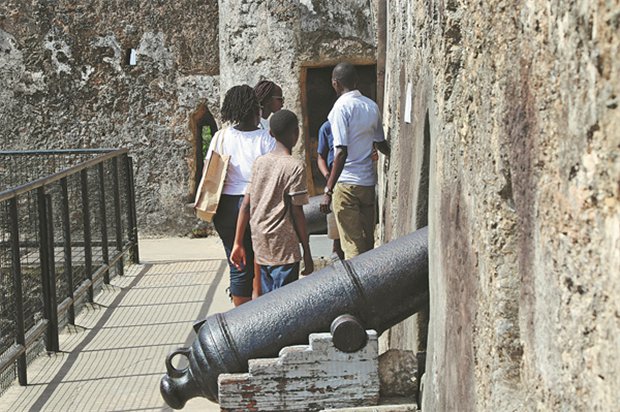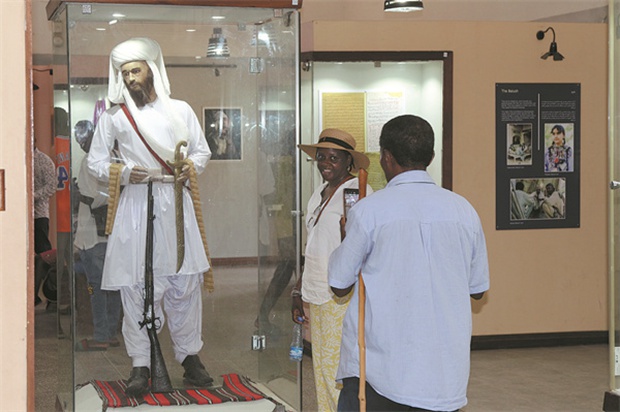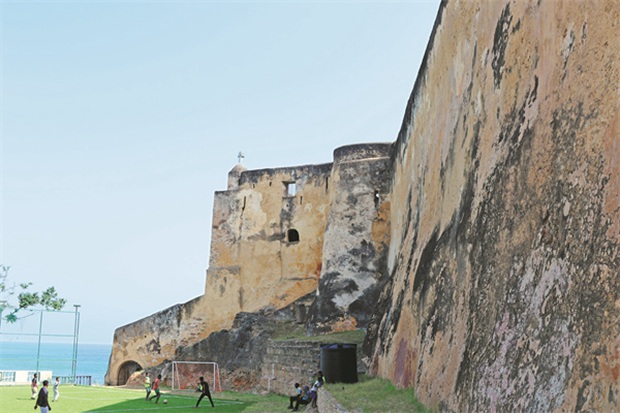Site dated back to early colonial conquest in Africa tells the story of multicultural, interconnected Indian Ocean
Built by the Portuguese toward the end of the 16th century on the Kenyan coastline in Mombasa city, Fort Jesus tells the story of early colonial conquest in Africa and how the Portuguese at one time ruled the trade routes of the Indian Ocean.
Lawrence Juma, a local tour guide, said that no fort in Africa has undergone as much turmoil as Fort Jesus. The massive and imposing fort has repeatedly changed hands since it was built by the Portuguese as states fought for control of this key choke-point for the flow of regional trade.
"From 1631 to 1875 Fort Jesus changed hands several times, being captured, overrun and recaptured by the Portuguese, Arab soldiers, African Swahili warriors and British colonialists. The battles for the control of the fort were fierce because whoever took over the fort became the master of the growing city of Mombasa and the wealth of the Indian Ocean trade routes," Juma said.
Built between 1593 and 1596, the fort, which is protected by plastered coral walls as high as 18 meters, features a starlike, angular shape, designed so that any assailant trying to climb any of the walls could easily come under fire from one of its many watchtowers, and so that cannonballs would be more likely to ricochet rather than scoring a direct hit.
Seen from the air, the fort, which was designated a UNESCO World Heritage Site in 2011, was designed in Renaissance fashion to reflect the proportions of the human body, and looks like a man lying on his stomach facing the ocean.
"After completion the fort quickly became a vital asset for those desiring to control Mombasa Island and the surrounding trade routes and was won and lost nine times during various battles for the control of Kenya between 1631 and 1875 before finally resting with the British," Juma said.
Walking around the fort, one can see elements left behind by each of the major powers that once occupied it. British and Portuguese influence can be seen in the various cannons found in the fort while the Omani Arabs marked their occupation by etching Koranic inscriptions into the wooden door posts and ceiling beams.
Fort Jesus was occupied by the Portuguese for almost a century, who used it as the main point of control over the port of Mombasa and the maritime traffic of the Swahili Coast. When it later fell into the hands of the Omani sultan, it was turned into an administrative center. When the British took over, the fort was converted into a prison until the eve of independence in 1958 when it was declared a National Monument.
Today the fort, which sits on a 2.36-hectare site, is open to visitors who can view some of the surviving historical structures, including an open water cistern used by the Portuguese to harvest rainwater, the ruins of a church built by the Portuguese and a 23-meter deep well bored by the Arabs.

Cultural melting pot
The fort was designed by Giovanni Battista Cairati, an Italian architect hired by the Portuguese to design forts in its colonial possessions in Africa and Asia, and was the first Italian-style bastion constructed outside of Europe. In April 1593 the fortress was named "Fortaleza de Jesus de Mombaca" by Mateus de Mendes de Vasconcelos, who was in charge of Portuguese possessions on the East African coast at the time.
Although Fort Jesus' design is considered a masterpiece of trace italienne military fortification, local Swahili people contributed much of the masonry technique, building materials and labor.
There are several facilities within the fort for visitors to see including a house built in the 18th century for the Omani sultans, who in the late 17th century wrested the fort from the Portuguese after a protracted siege. "Here, you will find jewelry, weapons and other artifacts from the Arab occupation of the fort," Juma said.
"We also have the Mazrui Hall, which houses decorations and artifacts left by the fort's changing inhabitants through the centuries. It also has wall paintings and sketches from Portuguese sailors, drawings of Arab dhows, and pictures of traditional Swahili sailing ships," he added.
The fort features a Swahili Cultural Centre established in 1993 to educate visitors on traditional Swahili ways of life, Swahili influence on occupants of the fort, and Swahili arts and crafts. A museum located at the center of the fort displays Portuguese warships sunk during the siege conducted by the Arabs in 1697, which lasted three years and marked the final expulsion of the Portuguese from the region.
The museum also features artifacts collected along Kenya's coast that show the importance of this region to Asian trade networks long before the arrival of the Portuguese. Among the artifacts is a collection of porcelain from China's Ming (1368-1644) and Qing (1644-1912) dynasties. Though the younger pieces were likely brought by the Portuguese from their East Asian base in Macao, it is believed that the oldest pieces were brought to East Africa by Zheng He (1371-1435), a Ming admiral who commanded the largest fleet ever assembled at the time on a series of missions to bring far-flung states into the traditional Chinese tributary system.

Zheng He's voyages
Zheng made seven voyages to visit the city-states dotting the coast of East Africa between 1405 and 1433. Many porcelains and copper coins excavated at Swahili burial sites and ancient ruins along the East African coast have been attributed to his expeditions.
Among the Chinese porcelains displayed at the museum is a vase patterned with dragons chasing flaming pearls among cloud scrolls and pearl festoons. There is also a pair of small Chinese vases with floral panels in green, iron-red, yellow, manganese and a pale turquoise on a background of green tendrils with red chrysanthemums. Another small Chinese jar depicts a battle scene in iron-red, green, pink and manganese with a tarnished metallic border below the top and above the base and a varnish finish. In addition, the display also features a large Chinese plate with two dragons in gray panels surrounded by flowers and birds in turquoise, yellow, manganese and rose-pink enamel.
One famous find in Kenya, standing as a testament to early Chinese presence in East Africa, is a 600-year-old coin which is made of copper and silver and has a hole in the center so it could be placed on a string — a classic feature of old Chinese coins. The coin was issued by Emperor Yongle, who reigned between the years 1403 to 1424 and commissioned the Zheng He expeditions. It was found on Manda, an island on the Kenyan coast and is tangible evidence of Chinese exploration and trade in Africa nearly a century before the Portuguese reached this part of the world.
Tabitha Nakimera, a Ugandan national in Mombasa with her family for Christmas paid a visit to Fort Jesus and said that it was interesting to see how the building is a living testimony of the cultural interchange between Africans, Arabs, and Europeans.
"My children are so excited to visit the fort because by walking through the old halls and passageways, they feel like they are part of the history that existed in this place. In addition, the fort serves as a reminder of our shared history as East Africans because the British who last occupied the fort also colonized Uganda," Nakimera said.
Visitors to the fort have a chance to shop among the plentiful souvenir vendors in the area around Fort Jesus, one of the town's top tourist attractions. Traders in these shops offer high-quality handicrafts and African clothing, which visitors can take home as mementos.
Outside the fort visitors can also see a gun from the H. M. S Pegasus, a 2000-ton cruiser which was undergoing boiler repair in Zanzibar harbor in September 1914 when it was sunk by the German warship Konigsberg. The gun on display is one of eight which were salvaged from the ship and later mounted on wheels and used in coastal defense batteries in both Zanzibar and the city of Mombasa.
Despite having proven its longevity, surviving centuries of change, Juma said that the fort still requires preservation. National Museums of Kenya, the umbrella organization which manages the country's heritage institutions, is the main stakeholder in its conservation.
The tour guide added that long-term conservation and management issues facing Fort Jesus include the protection of the fort from urban encroachment, and controlling the erosion of the adjacent coastline.















